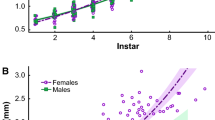Abstract
In invertebrates, the size at maturation is considered to be important for adult fitness. In the wolf spider Hygrolycosa rubrofasciata, however, it is only females that clearly benefit of larger size through augmented egg production, while male mating success is determined by display activity not related to size. Thus, we can expect conflicting growth patterns for the sexes. Additionally, populations differ greatly in adult size: individuals from dry habitats are smaller than those from wet habitats. To study the sexual differences in reaction norms of growth, we reared spiderlings from seven populations at two food levels under controlled laboratory conditions and compared size at sexual maturity. The shapes of reaction norms for adult size differed between the sexes. In females, the reaction norms were parallel, but individuals from dry habitats tended to grow larger at the given food levels. In males, there was a significant interaction between food level and population without any consistent differences between populations. Maturation time was a plastic character in both sexes with no genetic differences among populations. However, females on low food level matured later and significantly smaller in size than those on high food level. Males also matured later on low food level, but they were nearly of the same size as males that received more food. Female growth patterns reflected the strong selection for large size at maturity. However, the patterns for males were highly variable, which could be explained by the weak overall selection on male size, which means that any environmental factors can affect male growing patterns.
Similar content being viewed by others
References
Berrigan, D. and Charnov, E.L. (1994) Reaction norms for age and size at maturity in response to temperature: a puzzle for life historians. Oikos 70, 474-478.
Clutton-Brock, T.H., Guinness, F.E. and Albon, S.D. (1982) Red Deer: The Behavior and Ecology of Two Sexes. University Chicago Press, Chicago.
Darwin, C.R. (1874) The Descent of Man, and Selection in Relation to Sex. 2nd edn. Appleton, New York.
Ebert, D. (1994) A maturation size threshold and phenotypic plasticity of age and size at maturity in Daphnia magna. Oikos 69, 309-317.
Foelix, R.F. (1996) Biology of Spiders. 2nd edn. Oxford University Press, New York.
Gebhardt, M.D. and Stearns, S.C. (1988) Reaction norms for developmental time and weight at eclosion in Drosophila mercatorum. J. Evol. Biol. 1, 335-354.
Hedges, L.W. and Olkin, I. (1985) Statistical Methods for Meta-Analyses. Academic Press, Orlando.
Higgins, L.E. and Rankin, M.A. (1996) Different pathways in arthropod postembryonic development. Evolution 50, 537-582.
Honêk, A. (1993) Intraspecific variation in body size and fecundity in insects: a general relationship. Oikos 66, 483-492.
Kotiaho, J.S., Alatalo, R.V., Mappes, J., Nielsen, M.G., Parri, S. and Rivero, A. (1998) Energetic costs of size and sexual signalling in a wolf spider. Proc. Roy. Soc. Lond. Series B 265, 2203-2209.
Kotiaho, J., Alatalo, R.V., Mappes, J. and Parri, S. (1996) Sexual selection in a wolf spider: drumming activity, body size and viability. Evolution 50, 1977-1981.
Kotiaho, J.S., Alatalo, R.V., Mappes, J. and Parri, S. (1997) Fighting success in relation to body mass and drumming activity in the male wolf spider Hygrolycosa rubrofasciata. Can. J. Zool. 75, 1532-1535.
Kotiaho, J.S., Alatalo, R.V., Mappes, J. and Parri, S. (1999a) Sexual signalling and viability in a wolf spider (Hygrolycosa rubrofasciata): measurements under laboratory and field conditions. Behav. Ecol. Sociobiol. 46, 123-128.
Kotiaho, J.S., Alatalo, R.V., Mappes, J. and Parri, S. (1999b) Overwintering survival in relation to body mass in field population of the wolf spider (Hygrolycosa rubrofasciata). J. Zool. Lond. 248, 270-272.
Mappes, J., Alatalo, R.V., Kotiaho, J. and Parri, S. (1996) Viability costs of condition-dependent sexual male display in a drumming wolf spider. Proc. Roy. Soc. Lond. Series B 263, 785-789.
Marcussen, B.M., Axelsen, J.A. and Toft, S. (1999) The value of two Collembola species as a food for a linyphiid spider. Entomol. Experiment. Appl. 92, 29-36.
Parri, S. (1999) Female Choice for Male Drumming Characteristics in the Wolf Spider Hygrolycosa rubrofasciata. Biological Research Reports from the University of Jyväskylä 77.
Rivero, A., Alatalo, R.V., Kotiaho, J.S., Mappes, J. and Parri, S. (2000) Acoustic signalling in a wolf spider: can signal characteristics predict male quality? Anim. Behav. (in press).
Roff, D.A. (1992) The Evolution of Life histories: Theory and Analysis. Chapman Hall, New York.
Savalli, U.M. and Fox, C.V. (1998) Sexual selection and the fitness consequences of male body size in the seed beetle Stator limbatus. Anim. Behav. 55, 473-483.
St Clair, R., Gregory, P.T. and Macartney, J.M. (1994) How do sexual differences in growth and maturation interact to determine size in northern and southern painted turtles? Can. J. Zool. 72, 1436-1443.
Stearns, S.C. and Koella, J.C. (1986) The evolution of phenotypic plasticity in life-history traits: predictions of reaction norms for age and size at maturity. Evolution 40, 893-913.
Toft, S. and Wise, H. (1999a) Growth, development, and survival of a generalist predator fed single-and mixed species diets of different quality. Oecologia 119, 191-197.
Toft, S. and Wise, H. (1999b) Behavioral and ecophysiological responses of a generalist predator to single-and mixed-species diet of different quality. Oecologia 119, 198-207.
Zar, J.H. (1996) Biostatistical Analysis. Prentice-Hall International Editions, London.
Author information
Authors and Affiliations
Rights and permissions
About this article
Cite this article
Vertainen, L., Alatalo, R.V., Mappes, J. et al. Sexual differences in growth strategies of the wolf spider Hygrolycosa rubrofasciata. Evolutionary Ecology 14, 595–610 (2000). https://doi.org/10.1023/A:1011080706931
Issue Date:
DOI: https://doi.org/10.1023/A:1011080706931




